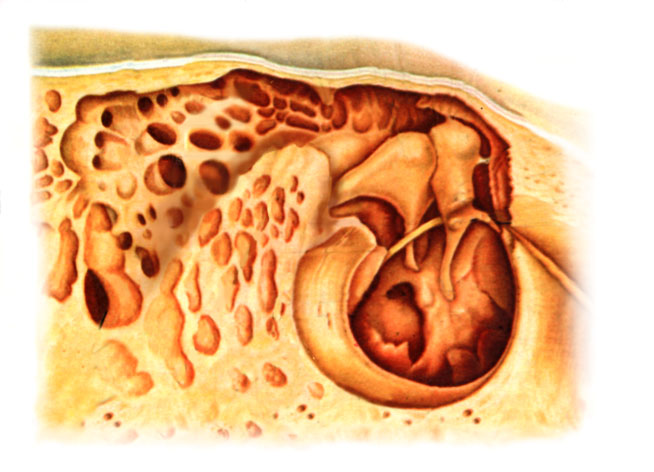
Variants of "Surgical Angle" of approach
to the Antrum

 |
Correction of Failures after Hinge-Like Stapedoplasty.Uliyanov Y.P. (XVII World Congress of Oto-Rhino-Laryngological Societies (IFOS) 28th Sept - 3rd Oct. 2002, Cairo. ) |
|
Abstract:As is known, only "hinge-like" stapedoplasty is enabling to restore the natural protective mechanism of the middle ear. However, in some patients hearing ability decreased by conductive-like type during six months later of restoration of a "hinge-like" mechanism of the stapes. This study was included 300 patients after "hinge-like" stapedoplasty. In 210 cases, the posterior crus of the stapes was used as a distance piece (cross-bar) for repair of the "hinge-like" mechanism on a posterior edge of the oval window, and a teflon-strut prosthesis of the crus posterior was putted in the others. In 71 re-operations the immobility of the sound conductive system was found out, which was brought about by adhesion of the crus posterius of the stapes with promontory, because of their contact. In 47 from them, the crus posterius was thinned by cutting away of its half to prevent the contact with promontory and with good result over year. Whereas, this method was failed in 24 re-operations, because the crus posterius was destroyed and then the teflon-strut prosthesis was utilized. Therefore, in subsequent "hinge-like" stapedoplasty, when the stapes was closeness with promontory, we tried to splinter up the crus posterius of the stapes with removing of its half, that allowed to avoid a contact together with the promontory and risk of consequent adhesion between they.INTRODUCTIONToday, after universal success of microsurgery an ear with achievement of hearing improvement more than in 90 % irrespective of a used technique of a stapedoplasty or stapedectomy, the problem of a recuperation and restorations of the protective function of middle ear became most important. It is caused by that a restorations only conductive-like type, without a restorations of the protective mechanism of middle ear (for this purpose the nature also has created the middle ear muscles - Fig. 1),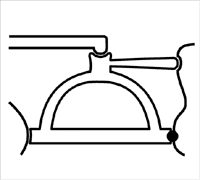 results in a hyperacusia and vestibulopathy, that is invalid for trades
are connected to noisy conditions or with vestibular overloads and is especial
for children.
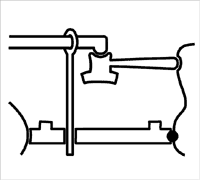 Our scientific development [Uliyanov Y.P 1997] have shown, that to restore the protective mechanism of the middle ear it is necessary to recover the "hinged mechanism" (C) at the posterior edge of the fenestra vestibuli (A), which would be similar to the natural one. This could be achieved only through making the prosthesis of the crus posterius in the shape of a "cross-bar" (spreader) (9) between the caput stapedis (1) and the posterior edge of the fenestra vestibuli (A), forming thereby a "hinged mechanism" (C) at the posterior edge of the fenestra vestibuli (Fig. 3),(Fig. 4) 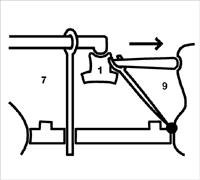 This method was named as the "hinge-like" stapedoplasty (Patent of the USSR No 1792649). However, this method of stapedoplasty with a "spreader" (9) is connected with additional difficulties, as increased technical demands are placed on the otological surgeons performing this procedure and the operative time is longer. Therefore, we have developed a special complex prosthesis for the "hinge-like" stapedoplasty (Russian Federation's Patent No 016372), which permits a simultaneous recovery of the sound-conducting mechanism and the "spreader" mechanism (Fig. 5). 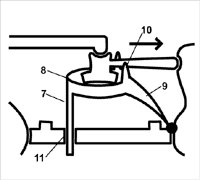 In placing this stapes prosthesis, all the surgeon has to perform is
to put the caput stapedis ahead two superior projections of the prosthesis
(10), between which the tendon of the M.stapedius is put.
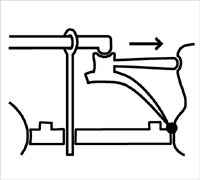 which we more often use too.
METHODThe study included 300 patients after "hinge-like" stapedoplasty aged from four to 62 years, including 183 women (200 patients were operated upon before 1996 and 100 during the recent (subsequent) years). The crus posterius of the stapes was used as a "spreader" in 210 cases and at other patients instead of the crus posterius of stapes was used teflon "spreaders". An analysis was carried out to establish the mechanism of the postoperative disturbance of the sound conduction with the resulting impaired hearing in them. Therefore, the more successful variant of "hinge-like" stapedoplasty was developed, which allows to prevent the revealed deterioration of hearing in the postoperative period at these patients. RESULTWithin six months after surgery hearing was impaired in 82 (27,3%) patients.
Because of impaired sound conduction, hearing was impaired in 76 (25,3%)
patients from this group where the crus posterius of the stapes was used
as a "spreader". In 71 cases, a re-operation revealed immobility of the
sound conduction system brought about by adhesion of the crus posterius
of the stapes with the promontory of cochlea . This adhesion was caused
by the pronounced form of the promontory wall, with resulting contact with
the crus posterius of the stapes (Fig. 6 ).
The patients' age ranged from 20 to 56 years, with 51 women among them.
In the first 24 cases, the crus posterius of the stapes was removed and
replaced with the teflon "spreader" (Fig. 3 ). In subsequent 47 cases we
tried to keep the crus posterius of the stapes for a restorations of the
"hinged mechanism " (Fig. 4). But for prevention of contact (and development
synechiaes) between the crus posterius of stapes and promontory we specially
made the crus posterius is more thin.
it was dragged to the promontory upside-down, which enabled splitting
of the same with the acute microchisel with consequent cutting of its half
near the caput stapedis. This variant of "hinge-like" stapedoplasty was
successfully executed at re-operation at 36 patients with positive results
on an extent more than 1,5 years, that is the sufficient proof
of efficiency of a method, because the adhesion process in these cases
develops per the first half of year only.
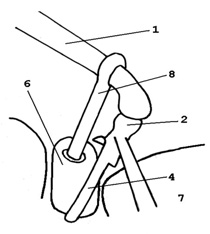 CONCLUSION1. The main reason of impaired hearing after the ''hinge-like''
stapedoplasty is adhesion of the crus posterius of the stapes with the
adjacent promontory -25,3%.
REFERENCES[1]Uljanov J. P.. The method of creation of a ''hinge'' at the posterior edge of the fenestra ovalis. From: Some ways of reducing Trauma of the Eer in stapedoplasty and stapedectomy. By N.A.Preobrajensky (Scientific Research Institute of Otolaryngology, Moscow, USSR). V111- th. International Congress of OTORHINOLARYNGOLOGY, Tokyo, October 1965, No.113, 377- 379.[2]Uliyanov Y.P. . Stapedoplasty and stapedectomy with ''hinge'' at the posterior edge of the fenestra ovalis. File from: ''Stapedoplasty and stapedectomy with teflon-piston''. The Master's thesis (Dissertation of the candidate) of medical sciences. Moscow,1967, 345 p. ( In Russian). [3]Uliyanov Y.P. The method of ''hinge-like'' stapedoplasty. From:
[4]Uliyanov Y.P. The Russian PATENT ╣ 1792649, on the invention under the application ╣ 0910378 from 6 July 1964. Repair of the hinged mechanism of the stapes. The Bulletin of the Inventions and Opening Russian. [5]Uliyanov Y.P. Repair of the hinged mechanism of the stapes. XYI - World Congress Of Otorhinolaryngology Head and Neck Surgery. (Sydney, Australia, 2-7 March, 1997), p.1077-1080. [6]Uliyanov Y.P .Correction of Failures after Hinge-Like Stapedoplasty J.Otolaryngology-Head and Neck Surgery. 1999, V.121, N. 2, p.202. [7]Uliyanov Y.P. The Russian PATENT ╣ 2118895, on the invention
under the application ╣ 96110084 (016372) from 27 May 1996. The device
of the "hinged" stapedoplasty. The Bulletin of the Inventions and Opening
Russian. ╣ 26; 20.09.1998. ( In Russian).
|

